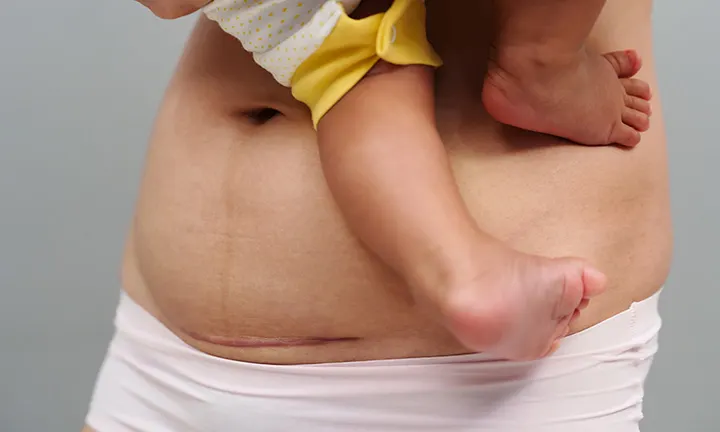Explore
All About C-Section Scars and Incisions
If you’ve had a cesarean delivery, commonly called a C-section, or are preparing for one, perhaps you’re wondering how your scar will heal. There are many questions surrounding the aftermath of your cesarean section: How long does it take for a C-section scar to heal? What happens if your C-section scar or incision gets infected? How do you clean the C-section incision? Will it prevent future vaginal births? Read on to get the answers to all these questions and more.
What’s a C-Section and Why Might You Need One?
A cesarean section or a C-section is a surgical procedure in which a doctor delivers your baby through incisions made in your abdomen and uterus. This is opposed to delivering your baby in the traditional way, via a vaginal birth.
Your healthcare provider may plan for a cesarean section if they determine that a vaginal delivery isn’t safe for you. For example, your provider may schedule a C-section if you have a particular health concern, or you are carrying more than one baby, or if your baby’s position is sideways or breech (feet or bottom down).
Your provider might need to perform what’s known as an emergency cesarean section, which is an unplanned C-section. You might need an emergency C-section if any complications arise during labor and delivery, such as a stalled labor or issues with the umbilical cord.
Even if you know you’ll need a C-section, you can still prepare a birth plan to give to your healthcare provider. Download our birth plan guide below.
Types of C-Section Incisions
The look of your cesarean section scar will depend on the type of C-section incision you receive in your abdomen. There are three types of C-section incisions, all of which are healthy and safe:
Low transverse. This common option is also known as the “bikini incision” because the C-section cut curves horizontally across your bikini line (your lower abdomen). This cut is ideal because it causes the least amount of pain and gives your healthcare provider the best view of your lower uterus. A lower transverse C-section incision typically creates a strong scar that heals well.
Low vertical. This cut is similar to a transverse C-section incision, but the cut extends vertically down your lower abdomen rather than horizontally. This may be a good option if your baby is positioned feet first, bottom first, or sideways.
High vertical. This incision has the same shape as a low vertical cut, but it sits higher on your abdomen and across your stomach. This C-section incision is best for pre-term babies, those positioned sideways, or for emergency cesarean sections.
Many factors determine which type of C-section incision your healthcare provider will make, including
whether you have a planned or emergency cesarean section
whether you’ve had the surgery in the past
the size and position of your baby
the size and position of the placenta.
After the initial abdominal incision is made, you’ll also receive a uterine incision. So, you technically receive two incisions and C-section scars, but one is internal, and you won’t be able to see it.
What Do C-Section Scars Look Like?
Regardless of the type, most abdominal incisions are about six inches in length, creating a scar of the same size. The uterine incision is typically smaller. The majority of C-sections use the bikini incision (low transverse incision), which offers a cosmetic perk, in that the scar will usually stay hidden underneath your underwear or swimsuit.
Low vertical and high vertical C-section incisions are less common, but if you receive one, you’ll have a scar running vertically across your stomach or lower abdomen. Emergency C-sections will typically result in this type of scar.
Even if your abdominal incision is vertical, it’s likely that your uterine incision will be low transverse. Again, this cut provides better access to your lower uterus and usually forms a stronger scar.
C-Section Scar Healing Stages
It takes time for your body to recover from a cesarean section, and that includes the healing of your incision site and scar. Like all scars, yours will look less prominent over time. Give yourself grace, be patient, and know that time heals all wounds—in this case, literally!
After Giving Birth
Soon after delivering your baby, your healthcare provider will close your incisions, most likely using dissolvable stitches for your C-section uterine opening. To close the abdominal incision opening, dissolvable stitches are possible, but other materials could also be used, such as surgical staples, thread, or surgical glue.
As you recover from your cesarean section, you’ll stay in the hospital for about two to four days, likely being able to eat, drink, and walk around within 24 hours of your surgery. Keep in mind that you’ll probably feel some pain, especially around your C-section incision and scar.
The first several days after your cesarean section are crucial in terms of general recovery and scar healing. You’ll need to avoid sudden movements, but doing some light walking may help improve blood circulation and promote healing. You’ll want to rest and sleep effectively, so use pain medication as instructed by your healthcare provider.
Recovering at Home
If you received traditional stitches or surgical staples, the hospital will release you after removing them. For the next few weeks, the incision site and your scar will likely be sore, sensitive, and itchy, but there are a few things you can do at home to care for the incision and work toward having a healed C-section scar.
Follow these guidelines to help promote your C-section scar recovery and general well-being:
Take it easy. As your incision starts to heal, you’ll probably feel pain when moving or using your abdominal muscles. Take it easy but try to incorporate some light walking into your schedule to help your body recover. Ask friends, family, or your partner to help with heavy lifting and driving, and avoid sex for at least four to six weeks after surgery.
Don’t scratch. Chances are that itching will occur as your C-section scar heals. As much as you can, avoid scratching! Instead, apply lotion to soothe your skin, just as you may have done with your itchy body during pregnancy.
Wear loose clothing. Because your C-section scar may feel sensitive, you might want to wear loose clothing that won’t rub against your incision.
Use gauze. Bleeding and discharge can occur as your C-section incision heals, and wearing a piece of light gauze over your scar may help in the first weeks.
Keep the area clean and dry. Your healthcare provider may give you instructions on how to clean a C-section incision, but in general, you’ll want to shower or bathe as you usually do, being careful to dry the incision thoroughly with a clean towel.
Resuming Activities
After the first few weeks, your abdomen will likely start to feel better, but your C-section scar recovery will continue. At about four to six weeks post-surgery, you may still feel symptoms of your cesarean section, including
pain at the C-section incision site
bleeding or discharge at the incision site
redness and swelling around the incision
mild cramping (especially when breastfeeding)
pulling or twitching sensations
itchiness and burning.
At this point, you’ll probably feel very ready for your recovery to be done! Although you may still experience some symptoms, the good news is that between four and six weeks postpartum you can talk to your healthcare provider about resuming activities. You may be ready to have sex again or enjoy some light exercises, such as swimming and more brisk walking.
Checking in With Your Healthcare Provider
The latest recommendations on postpartum care involve checking in with your healthcare provider by phone, video chat, or in person within three weeks of giving birth, followed by a full, in-person examination within 12 weeks of giving birth.
During these visits, besides discussing your mood, energy levels, sleeping habits, and caring for your newborn, your provider will also examine your C-section scar to determine how your recovery is going. After six weeks, it’s possible to be fully healed, but everyone is different.
Infected C-Section Scar
An important part of C-section incision care is watching for signs of infection, as any surgical wound can become infected. Signs of complications with a cesarean section scar include
fever higher than 100.4 degrees Fahrenheit
painful urination or heavy vaginal discharge (lochia)
a visible tear in the incision
severe redness, heavy discharge, or a strong smell around the C-section incision site
severe abdominal pain.
If your C-section scar or incision site becomes infected, contact your healthcare provider, who will recommend appropriate treatment. Most likely, you’ll receive antibiotics; but if it’s a particularly advanced or deep infection, you may require additional surgery.
Other Cesarean Section Complications
A cesarean section is major surgery, so you may wonder about other complications developing besides infection. You’ll be happy to know that complications are generally rare.
Still, some women still ask themselves, How do I know if my C-section opened inside my abdomen? If you are troubled by this possibility, know that it is very rare for your uterine incision to open up! Be sure to reach out to your healthcare provider for reassurance and answers to any questions or concerns.
Other rare complications include hemorrhage, blood clotting, and injury to your bowel or bladder. Your provider will help you prepare and recover from a C-section, as well as taking all necessary precautions during the surgery, so rest assured that you’re in good hands. Just keep an eye on your incision site and report any of the aforementioned symptoms of infection to your provider.
C-Section Scar Treatments
No one loves a scar, but your cesarean section scar is a true badge of honor! Your body worked hard to nurture your little one inside that baby bump, and you have the literal scars to prove it. These will fade and become less noticeable over time. That said, some women wonder if it's possible to make a C-section scar look less visible with treatments.
All scars heal differently, and your C-section scar could develop into what’s called a keloid, which occurs when a lump of overgrown scar tissue appears above the skin, creating a hard ridge. Keloid scars can continue to grow and may spread. Or sometimes a C-section scar simply appears raised, which is known as a hypertrophic scar. Whether you have a typical scar, a keloid, or a hypertrophic scar, what can you do about it?
Talk to your healthcare provider about possible treatments and strategies for minimizing scars. Your provider might be able to help directly, or may refer you to a specialist, such as a dermatologist. These are some of the standard preventive strategies and treatments for scars:
Silicone treatments. Applying silicone ointment, gel, or a silicone gel sheet may help prevent C-section scars from forming in the first place.
Pressure therapy. Similarly, pressure therapy paired with massage can prevent a scar from forming—or decrease the size if one does form.
Dermabrasion. Often used for acne scars, dermabrasion smooths bumps on the skin by gently “sanding” it.
Injections. Medications such as corticosteroids may be injected directly into your skin to help flatten scars and reduce pain and itching.
Laser treatments. These treatments use a particular wavelength to target blood vessels in the skin and help make scars less noticeable.
Surgery. Some scars can be removed or reduced in size with surgery. The surgeon can also place a skin graft at the site of an old scar to promote healthy skin.
Consult your healthcare provider if you’re interested in any of these treatments during your C-section scar recovery process.
Vaginal Birth After Cesarean Section (VBAC)
After having a cesarean section, you may wonder how it will impact future childbirth. Although medical experts once believed that women who had cesarean sections must always have them in future births, today it’s possible to attempt a vaginal birth after a C-section, which is known as a trial of labor after cesarean (TOLAC).
Many women are successful with TOLAC and end up having a vaginal birth after cesarean (VBAC). In fact, between 60 and 80 percent of women have healthy vaginal births despite having had a previous C-section.
The major risk of a VBAC is that, while pushing, your previous uterine incision may open, known as a uterine rupture. If this happens, your healthcare provider will assess the situation and determine if an emergency C-section is needed.
If you had a C-section with a previous birth and want to try a TOLAC for your next one, talk to your healthcare provider. Your provider can help you decide if it’s a good choice for you, taking into consideration factors like where your C-section scars are located, medical conditions, and the hospital you prefer, to name a few.
The Bottom Line
Cesarean sections come with a lot of follow-up questions, and we hope this guide helps you understand C-section incisions and scars! All in all, the type of incision you’ll receive depends on what’s best for you and your baby at the time of birth. Rest assured that your healthcare provider will do everything possible to minimize pain and scarring, as well as keeping you and your baby safe.
With a thorough and healthy C-section scar recovery routine, you’ll most likely heal well, avoid an infected incision, and be able to resume some normal activities after about four to six weeks. Although you might experience some pain, itching, and twitching sensations on your C-section scar, know that those symptoms are just temporary.
You’ve pulled off a little miracle and have the scars to prove it! But if you want to minimize a C-section scar, consult your healthcare provider about some common treatments and prevention methods, such as silicone treatments, pressure therapy, or dermabrasion.
Learn more about what happens postpartum and start earning rewards on all those future diaper changes with our Pampers Club app!
How We Wrote This Article The information in this article is based on the expert advice found in trusted medical and government sources, such as the American Academy of Pediatrics and the American College of Obstetricians and Gynecologists. You can find a full list of sources used for this article below. The content on this page should not replace professional medical advice. Always consult medical professionals for full diagnosis and treatment.
Join a World of Support
through Pregnancy and Parenthood.
TRACK WITH TOOLS
LEARN WITH EXPERTS
GET REWARDED
























